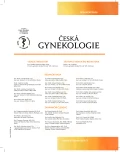Paraneoplastic neurological syndromes in gynecological malignancies
Authors:
L. Janzová 1,4; Luboš Minář 1
; P. Praksová 2; L. Frola 3; P. Ventruba 1
Authors‘ workplace:
Gynekologicko-porodnická klinika LF MU a FN, Brno, přednosta prof. MUDr. P. Ventruba, DrSc., MBA
1; Neurologická klinika LF MU a FN, Brno, přednosta prof. MUDr. J. Bednařík, CSc.
2; Ústav patologie LF MU a FN, Brno, přednosta doc. MUDr. L. Křen, Ph. D.
3; Gynekologicko-porodnické oddělení nemocnice, Ivančice, primář MUDr. J. Pulkert
4
Published in:
Ceska Gynekol 2016; 81(3): 186-191
Overview
Objective:
The demonstration of life-threatening paraneoplastic syndrome with dominant neurological symptomatology in germinal ovarian malignancy.
Design:
Literature review with case report.
Setting:
Department of Gynecology and Obstetrics, Faculty of Medicine Masaryk University and University Hospital Brno.
Methods:
The review outlines the issue of paraneoplastic syndromes. It describes the etiopathogenesis, the range of clinical symptoms, the diagnostic and therapeutic possibilities, along with a relevant case study which focuses on the paraneoplastic neurological symptoms in malignant germinal ovarian tumor.
Conclusion:
Although paraneoplastic symptomatology is rather rare, it constitutes an important part of the clinical picture of malignant tumors. In a number of cases, the paraneoplastic neurological syndrome (PNNS) symptoms precede the actual tumor diagnosis. The awareness of this connection can thus be important in early diagnostics, which in turn can significantly affect a patient‘s prognosis. Another important benefit of familiarity with the symptoms of neurological paraneoplasia is the fact that some PNNS are associated with specific tumors. Interdisciplinary cooperation is necessary in the case of PNNS for early tumor diagnostics. Treatment of the primary tumor is the key in diagnosed malignancies. With effective oncological treatment, adequate regression of paraneoplastic symptoms can be observed.
Keywords:
paraneoplastic neurological syndrome, malignant germinal ovarian tumor, anti-N-methyl-D-aspartate receptor encephalitis (anti-NMDAR encephalitis)
Sources
1. Adam, Z., Vorlíček, J., Koptíková, J. Obecná onkologie a podpůrná léčba. Praha: Grada Publishing, 2003, s. 127–154.
2. Ambler, Z. Paraneoplastické syndromy. Neurol prax, 2013, 14(1), s. 6–7.
3. Bajčiová, V. Nádory ovarií u dětí a adolescentních dívek. Onkologie, 2014, 8(2), s. 54–61.
4. Bechyně, K., Rosol, D., Apetauerová, D., et al. Atypický paraneoplastický syndrom – kazuistika. Čes Slov Neurol N, 2012, 75/108(3), s. 359–362.
5. Braik, T., Evans, AT., Telfer, M., et al. Paraneoplastic neurological syndromes: unusual presentations of cancer. A practical review. Am J Med Sci, 2010, 340, p. 301–308.
6. Cibula, D., Petruželka, L., et al. Onkogynekologie. Praha: Grada Publishing, 2009, s. 558–572.
7. Cushing, B., Perlman, E., et al. Germ cell tumors. Principles and practice of pediatrics oncology. Lippincot Williams and Wilkins, 2006, 5, p. 1116–1138.
8. Dalmau, J., Lancaster, E., Martinez-Hernandez, E., et al. Clinical experience and laboratory investigation in patients with anti‑NMDAR encephalitis. Lancet Neurol, 2011, 10(1), p. 63– 74.
9. Florance‑ Ryan, N., Dalmau, J. Update on anti N-metyl-D- Aspartate Receptor encephalitis in children and adolescens. Curr Opin Pediatr, 2010, 22(6), p. 739– 744.
10. Klener, P. Klinická onkologie. Praha: Galén, 2002, s. 82–83.
11. Kolařík, D., Halaška, M., Feyereisl, J. Repetitorium gynekologie. Praha: Maxdorf, 2011, s. 821–850.
12. Libá, Z., Hanzalová, J., Sebroňová, V., et al. Anti N-metyl-D-aspartát receptorová (NMDAR) encefalitida. Ces Slov Neurol N, 2014, 77/110(5), s. 624–630.
13. Maverakis, E., Goodarzi, H., Wehrli, LN., et al. The etiology of paraneoplastic autoimmunity. Clinic Rev Alerg Immunol, 2012, 42, p. 135–144.
14. Minář, L., Al Awad, H., Jandáková, E. Germinální tumory – heterogenní skupina ovariálních malignit. Gynekolog, 2013, 22(4), s. 146–149.
15. Minář, L., Al Awad, H., Kümmel, J. Paraneoplastické synromy v onkogynekologii. Čes Gynek, 2009, 74(3), s. 171–176.
16. Negishi, Y., Sakai, K., Noguchi, Y., et al. Paraneoplastic cerebellar degeneration caused by ovarian clear-cell carcinoma. J Obstet Gynaecol Res, 2014, 40(2), p. 614–617.
17. Pelosoft, LC., Gerber DE. Paraneoplastic syndromes, an approach to diagnosis and treatment. Mayo Clin Proc, 2010, 85, p. 838–854.
18. Pestana, I., Costal, A., Mota, R., et al. Paraneoplastic limbic encephalitis – neurologic paraneoplastic syndrome associated with ovarian malignancy – the importance of clinical recognition. Eur J Gynaecol Oncol, 2014, 35(5), p. 592–594.
19. Reys-Botero, G., Uribe, CS., Hernandez-Ortiz, OE., et al. Anti-NMDA receptor paraneoplastic encephalitis: complete recovery after ovarian teratoma removal. Rev Neurol, 2011, 152(9), p. 536–540.
20. Rosenfeld, MR., Dalmau, J. Anti‑NMDA‑ receptor encefalitis and other synaptic autoimmune disorders. Curr Treat Options Neurol, 2011, 13(3), p. 324– 332.
21. Štourač, P., Ambler, Z. Paraneoplastické neurologické syndromy –základní charakteristika, klasifikace, etiopatogeneze a diagnostika. Neurol prax, 2013, 14 (1), s. 8–11.
22. Zhang, M., Jiang, W., Li, G., et al. Ovarian masses in children and adolescents – an analysis of 521 clinical cases. J Pediatr Adolesc Gynecol, 2014,27(3), p. 73–77.
Labels
Paediatric gynaecology Gynaecology and obstetrics Reproduction medicineArticle was published in
Czech Gynaecology

2016 Issue 3
Most read in this issue
- Traumatic symphyseal rupture by vaginal delivery,report of a rare case
- The possibility of antepartal prevention of episiotomy and perineal tears during delivery
- Spontaneus delivery after two previous caesarean sections – case report
- Surgical treatment of endometriomas and ovarian reserve
